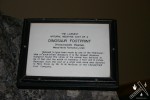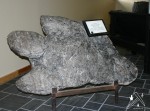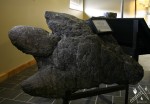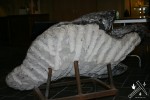Various Locations Around The World - All footprints here are from various sites around the world and from various periods. Although our intention is to focus on Triassic and Jurassic periods and to the Newark Supergroup Rift Basin, neglecting other sites and periods would be a terrible mistake. So much information can be gained by studying the fossils record outside of our primary scope. Here we present site photos and a limited description of each. Enjoy!
Triassic megatracksites in carbonate tidal flats of the Germanic Basin
Lower Muschelkalk vertebrate tracks of the Germanic Basin were described first of FABER (1958) from Winterswijk (E Netherlands). New findings occured in NW Germany at Haarmühle (HOLST, SMITH & VEENSTRA 1970). In the years 1976 to 1988 OOSTERINK did many taxonomic work about tracks of Winterswijk, in some papers togeter with DEMATHIEU. In the Teutoburg Forest new discoveries were made 1996 by the author later in the Osnabrueck hills (DIEDRICH 1998), Thuringia (DIEDRICH 2000) North Hess (DIEDRICH 2001) recently in Bavaria (Germany) and finally in Saxony Anhalt (Diedrich in prep).
Track bed high resolution Stratigraphy
Tracks occurr in "track beds" built of some cm thin up to 2 m in height laminites. In these track beds every laminae could be a "track horizon". Track beds allways contain many track horizons. These horizons situated in mm thinly beded algal laminates could not be correlated in contrast to the track beds. Many Middle Triassic track beds can be followed in different strata of the Upper Bunter, the Lower Muschelkalk or "Jena" Formation, the Middle Muschelkalk and basal Upper Muschelkalk in the Germanic Basin. The first track beds occurr in the uppermost Roet Member (Upper Bunter). Here up to four track beds are recently known. In the Lower Muschelkalk track beds are situated in the middle Lower Wellenkalk (muW1b) just below the "Rote Scheibengeröll-Bed". They are followed by track beds in the upper Lower Wellenkalk (muW1c) underlaying the Lower Oolith bed. Most tracks have been discovered in the Oolith member, especially in the "Graue Zwischenmittel" between the Lower and Upper Oolithic beds. The next tracks have been recovered from the lowermost Middle Wellenkalk (muW2a). At a few sites another thin track bed is situated at the top of the muW2b. Just below the Lower Terebratula bed at the top of the Middle Wellenkalk (muW2b) another horizon is widely distributed. The last track beds are found at the top of the Upper Wellenkalk Member in the so called Gelbe Plattenkalk-Horizont (top of muW3). Also in the overlaying Middle Muschelkalk two track beds occur in theorbicularis member (mm 1). The last track beds in the Middle Muschelkalk are of Upper Marl/Dolomite member (mm 4) time, one in the middle and one at the top of these member. In the Gelbe Basisschichten (moGB) of the basal Upper Muschelkalk a last track bed is present. A "Middle Triassic Megatracksite Project" (MTMP) about vertebrate tracks in carbonate tidal flats of the Germanic Basin during Muschelkalk Formation (Middle Triassic) was started. Many new localities were found since 1996 described here in a short internet presentation. New prospections are still in work to get further information of the middle Triassic megatracksites in the Germanic Basin.
http://www.paleologic.de/vertebratetracks1.html
(procolophonid parareptile)

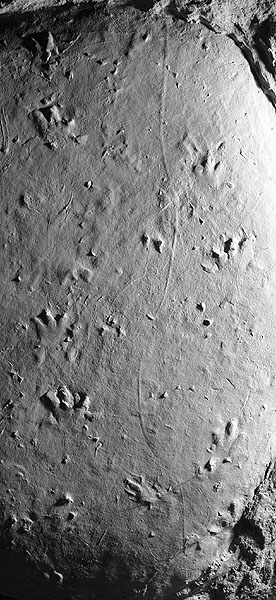
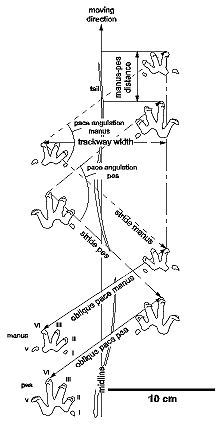
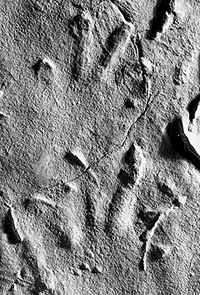


2) Procolophonichnium - trackway metric. Scetch: ©DIEDRICH2002.
3) Manus and Pes imprints of Procolophonichnium haarmuehlensis (HOLST, SMIT & VEENSTRA) of the mm1 of Detmold, (Teutoburg Forest, NW-Germany). Scale cm. Lippische Landesmuseum Detmold. No. mm 4. Fotos: ©DIEDRICH2001.
4) Procolophonichnium - trackway movement types. Drawing: ©DIEDRICH2002.
5) Procolophonichnium ichnofacies. Trackways and single imprints of Procolophonichnium haarmuehlensis (HOLST, SMIT & VEENSTRA) of Winterswijk, Lower Wellenkalk Member (muW1), Lower Muschelkalk(E-Netherlands). Negative slab. Scale 1cm. Geologisch-Paläontologisches Museum der Universität Münster. Foto: ©DIEDRICH2001.
(lepidosauromorphs)


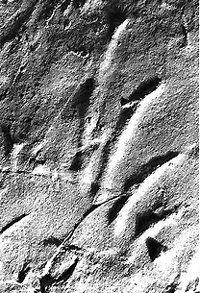
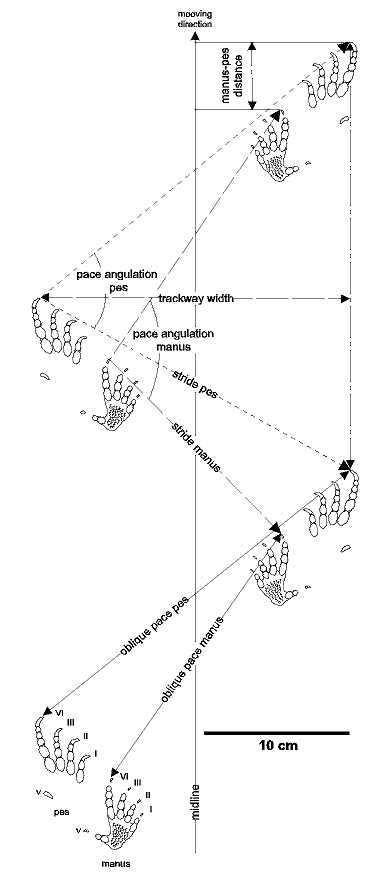
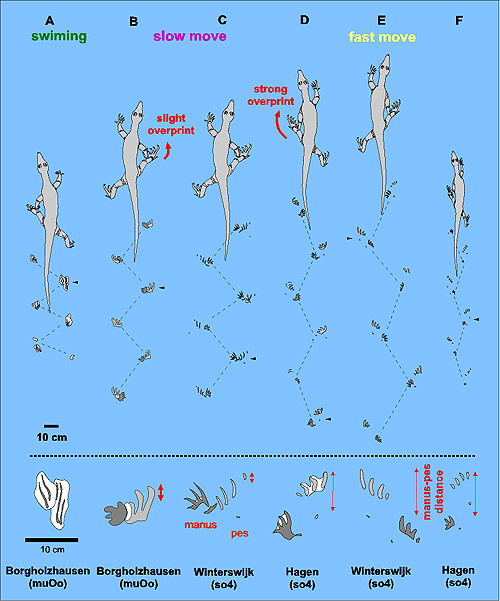
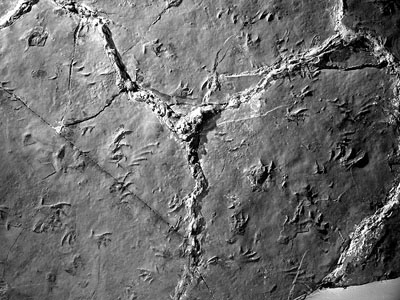
3) Rhynchosauroides - trackway metric. Scetch: ©DIEDRICH2001.
4) Rhynchosauroides - trackway movement types. Drawing: ©DIEDRICH2002.
5) Rhynchosauroides ichnofacies. Trackways and single imprints of Rynchosauroides of Winterswijk, Upper Röt Member (so4), Upper Bunter (East Netherlands). Negative slab. Scale 1cm. Naturkundemuseum Bielefeld. Foto: ©DIEDRICH2001.
(rauisuchian crurotarsan)


The excavation of dinosaur trackways (Wealden, Cretaceous) in the Weserbergland, Germany
Tridactyl dinosaur footprints were found by quarry worker Rainer Wiegmann in a sandstone quarry near Hannover in August 2004. Soon it became evident that several trackways of iguanodontids and theropods were excellently preserved in a siltstone layer covered with ripple marks. These trackways were formed 140 million years ago, when dinosaurs walked through mud on the sea shore. This shoreline connected probably several island in the area that is nowadays northern Germany. The trackways are so beautiful and rare that their subsequent excavation and scientific study was commenced. A cooperation between the Niedersächsisches Landesmuseum Hannover and the Dinopark Münchehagen was established to evaluate, prepare and excavate this unique find. The scientific work is conducted by Dr. Annette Broschinski (curator at the State Museum), Nils Knötschke (preparator at the Dinopark), and myself, Oliver Wings (currently on a scientific trainee position at the State Museum). However, without the help of many other people from the State Museum and the Dinopark, including several interns, this excavation would not be possible. The website was created as a diary to document the excavation Progress at irregular intervals. Visit the webpage for updates.
http://www.dinosaurhunter.org/weserber.htm





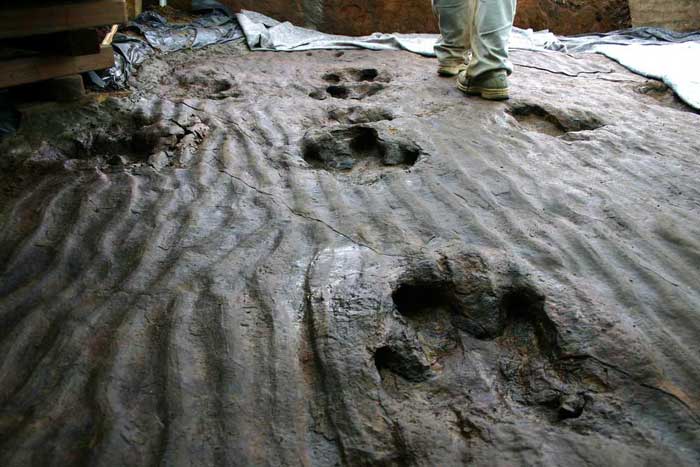

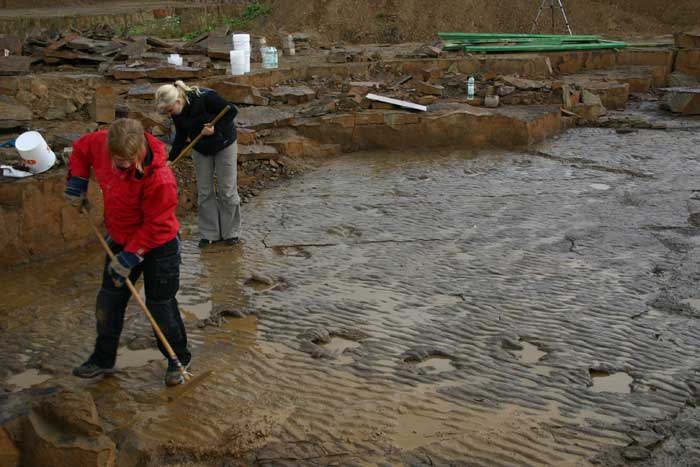
1) A block with several beautiful track casts. The only problem is its mass: about four tons.
2) Some tracks are covered with latex.
3) A possible theropod trackway in the middle of the photo, a deep iguanodontid on the right and a dirty hominid foot on the left.
4) The cleaned trackway, ready for casting.
5) Look at these deep imprints, it must have been very soft mud.
6) Three iguanodontids walked here 140 million years ago.
7) Cleaning off the top layer after a rain storm.
Permian Trackways on Coconino Sandstone from Northern Arizona
Fossil reptile trackways on Coconino Sandstone from Northern Arizona. This nearly 280 million year old specimen dates from the Early Permian Period of the Upper Paleozoic Era. It's not entirely known what reptiles made these tracks, they probably belonged to a group of mammal-like reptiles known as caseids. At the time these reptiles wandered the Colorado Plateau region of Northern Arizona, the area was covered by a desert environment of massive eolian deposited sand dunes. These ancient tracks were actually made in a dry dune environment, not in a wet one as commonly reported.
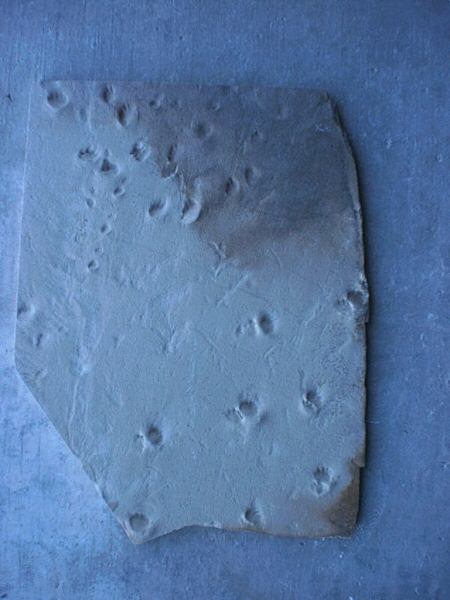

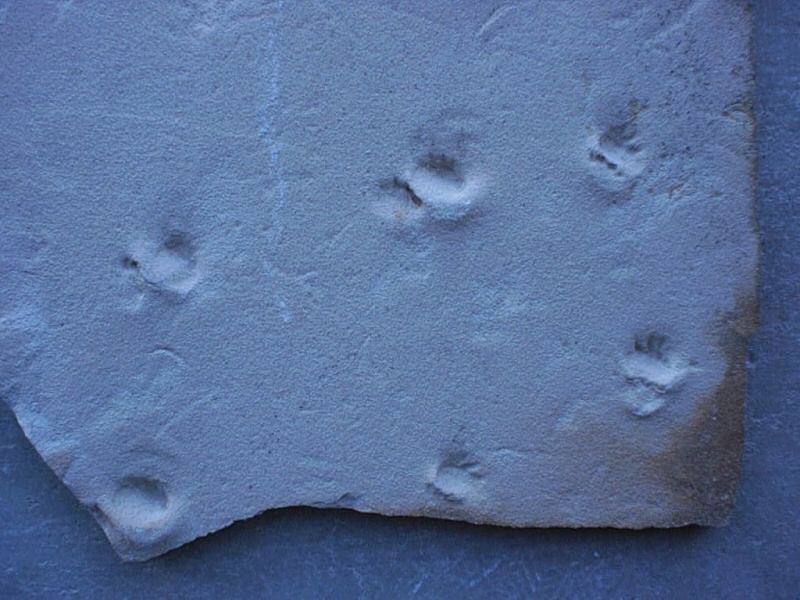
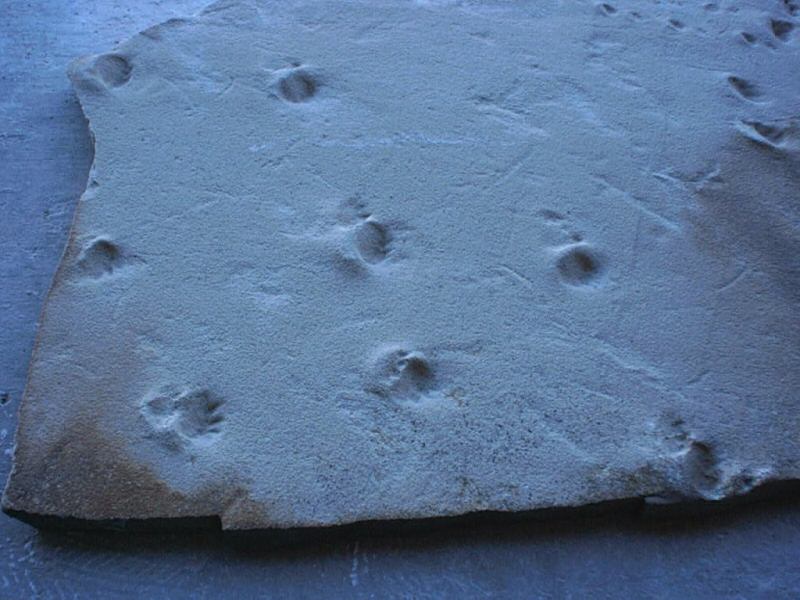
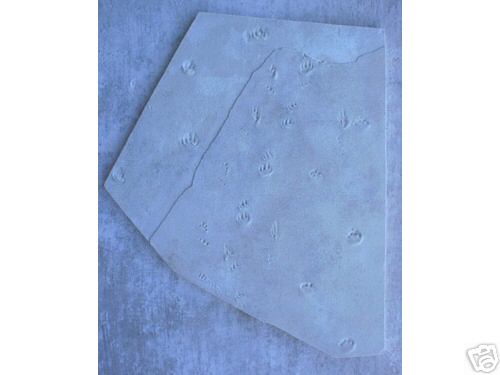

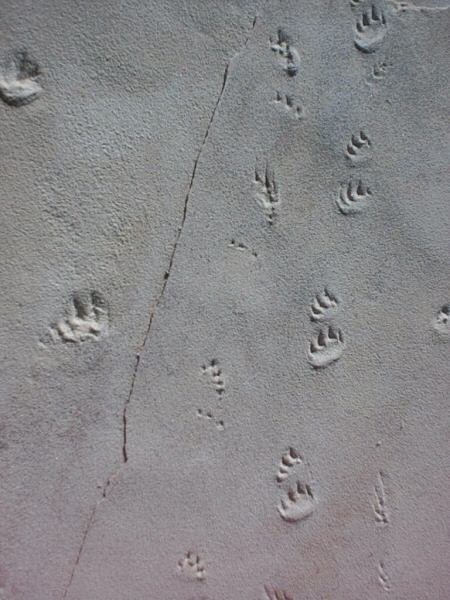
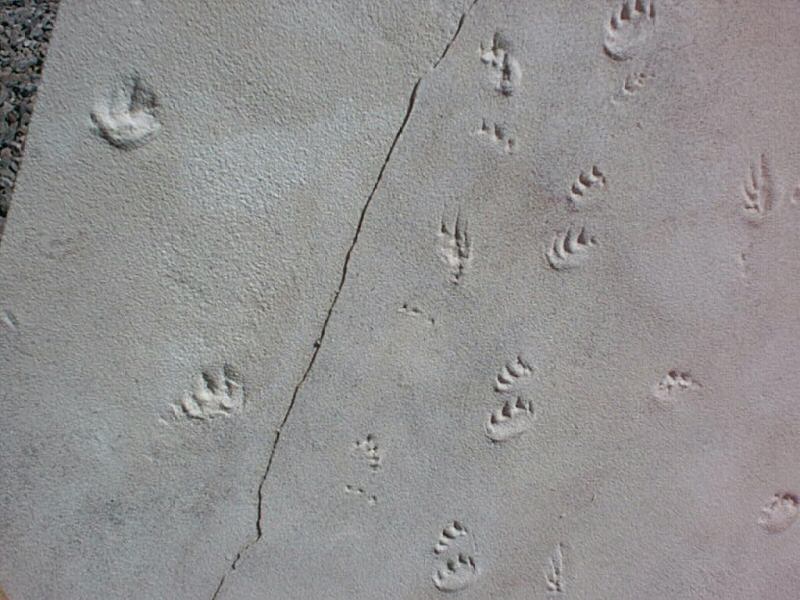


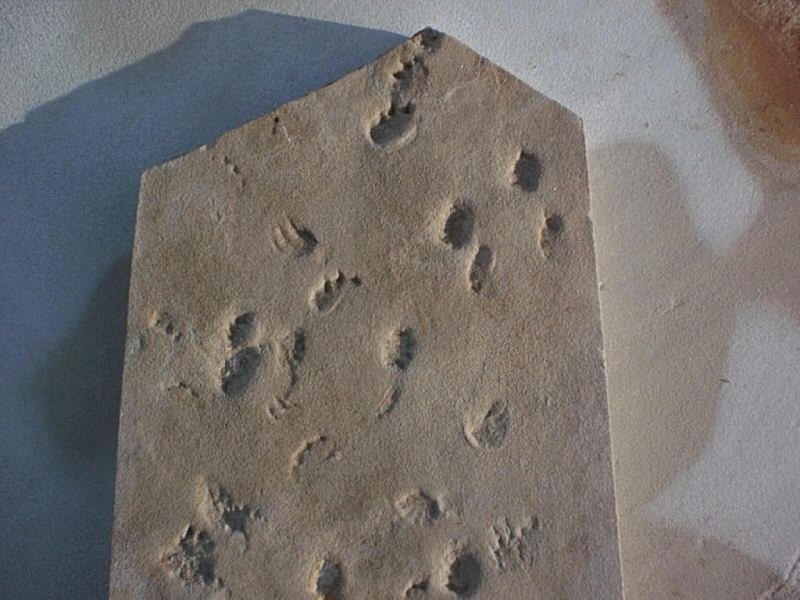
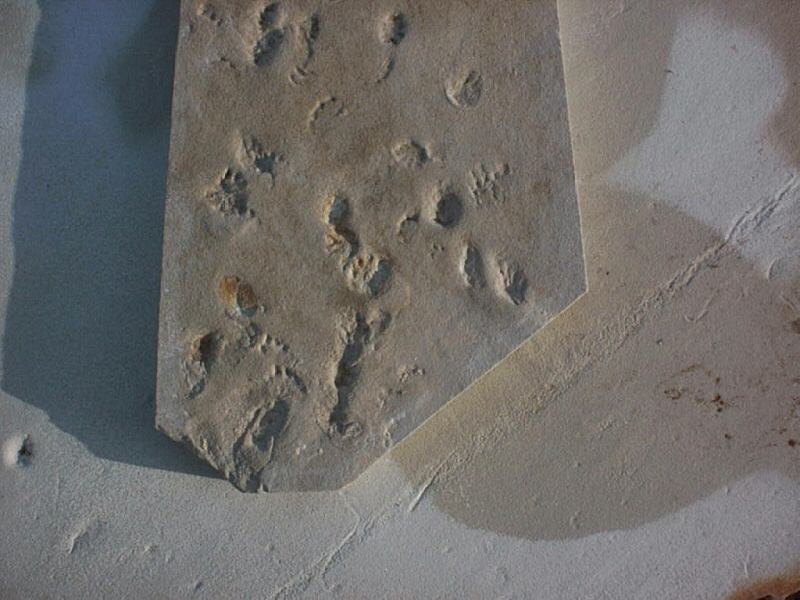
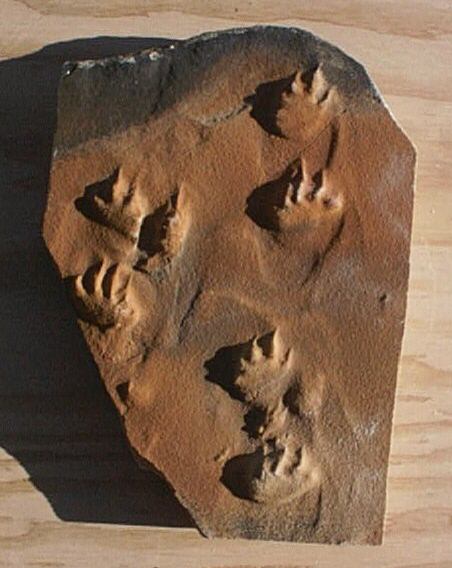
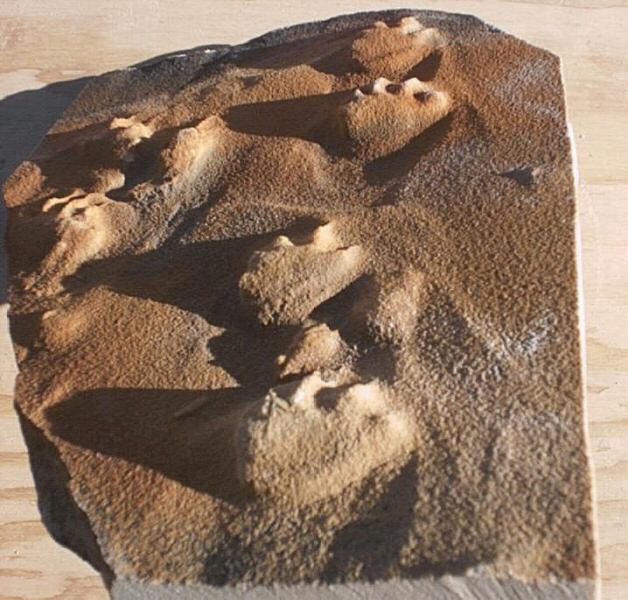



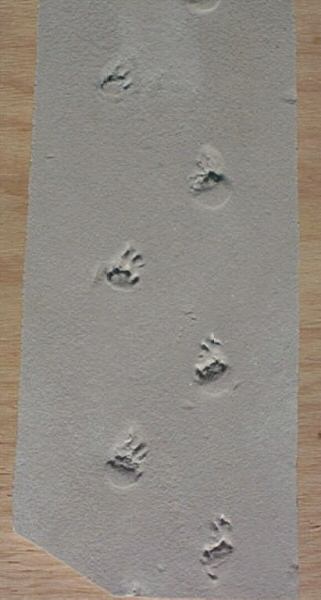
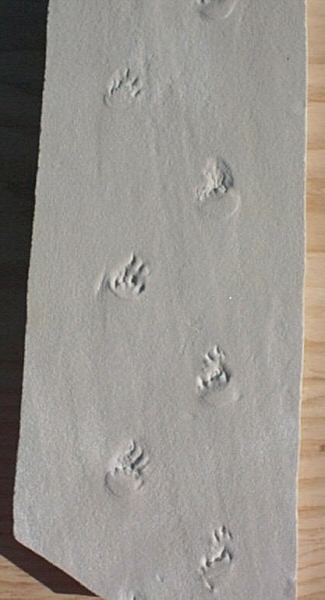
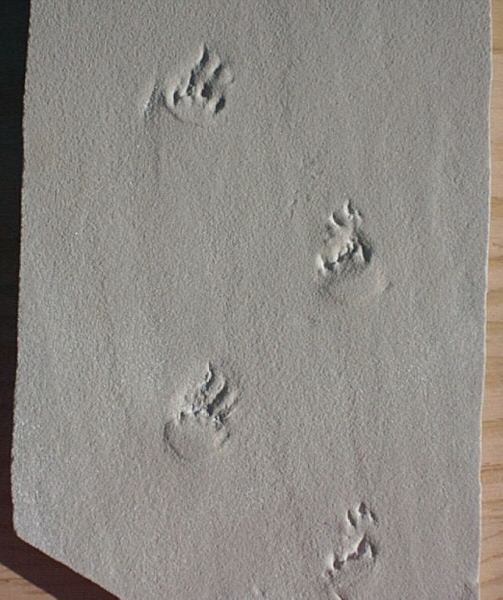


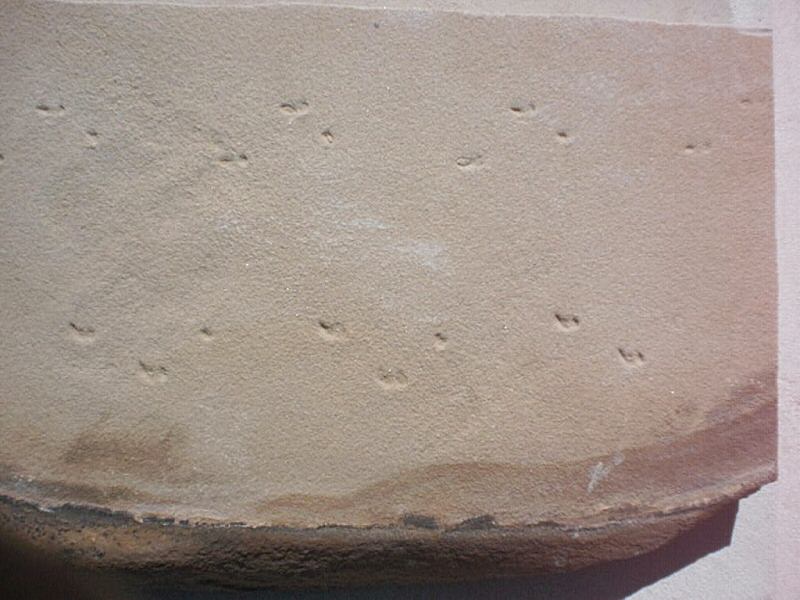
Picketwire Canyonlands Dinosaur Trackways, near La Junta, Colorado
There is a very long exposure of Jurassic age footprints in the Morrison Formation.
http://www.du.edu/~lconyer/picketwire_canyonlands_dinosaur_.htm
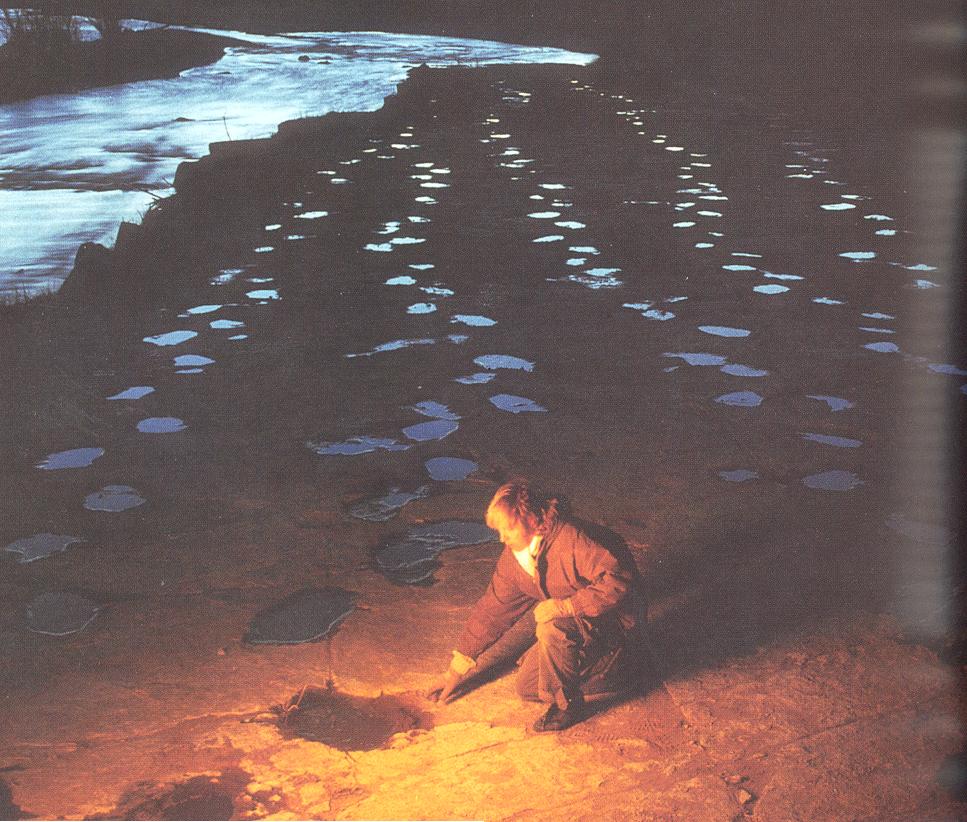

Lark Quarry, Winton, Queensland, Australia
This is a stampede site, but not an ordinary one. The Lark Quarry dinosaur trackways, situated 110 kilometres south-west of Winton in southern Queensland is believed to be the world's only preserved dinosaur stampede site. Some 93 million years ago, a large carnosaur trapped a group of much smaller dinosaurs on the edge of a prehistoric lake. The panicked footprints of the prey and the large stalking tracks of their predator, which have become fossilised over time, offer a brilliant snapshot of dinosaur life. There were three types of dinosaurs that left footprints - two types of theropods, which were two-legged meat eaters of the order Saurischia (lizard-hipped) and one ornithopod, two-legged plant-eaters of the order Ornithischia (bird-hipped).
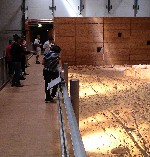
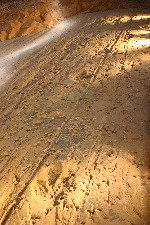
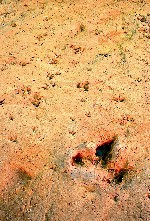
??? Quarry, Raritan Formation, Woodbridge, New Jersey
This footprint is one of seven discovered in 1920-1930 in a clay pit in Woodbridge, NJ. The animal was a carnivorous dinosaur named Megalosauropus. This is the only known Cretaceous age dinosaur footprint from the east of the Mississippi River. It's from the Raritan Formation (90 million years old).

Lagosteiros bay in Cabo Espichel, Seimbra region, Portugal
At the Lagosteiros bay in Cabo Espichel is a locality that reveals multiple track bearing levels from the upper Jurassic. The impressions in limestone are well conserved, two of which belong to a sauropod that limped, and excellent examples of herding sauropods that moved southeast. The local fishermen of the region have known these trackways since the 13th century. Without knowing how they where formed the legend was that they where left by a gigantic mule that transported the Virgin Mary from the sea up to the top of the cliff. The smaller sauropod prints ranged from 38-46 cm (pes length), and 25-30 cm (pes width), with a stride of 170-210 cm. The larger sauropod prints ranged from 70-73 cm (pes length), and 44-55 cm (pes width), with a stride of 230-265 cm. The set of theropod prints are also present which ranged from 42 cm (pes length), and 35 cm (pes width). Was the theropod stalking the sauropods?
http://www.mnhn.ul.pt/dinos/public_html/Jazidas/indexing.html



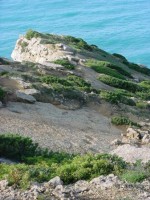

Fossilized dinosaur tracks in the limestone beds of the Paluxy River, near Glen Rose Texas
For many years claims were made by strict creationists that human footprints or "giant man tracks" occur alongside fossilized dinosaur tracks in the limestone beds of the Paluxy River, near Glen Rose Texas. If true, such a finding would dramatically contradict the conventional geologic timetable, which holds that humans did not appear on earth until over 60 million years after the dinosaurs became extinct. However, the "man track" claims have not stood up to close scientific scrutiny, and in recent years have been abandoned even by most creationists. The supposed human tracks have involved a variety of phenomena, including forms of elongate, metatarsal dinosaur tracks, erosional features, indistinct markings of uncertain origin, and a smaller number of doctored and carved specimens (most of the latter occurring on loose blocks of rock). A few individuals continue to promote the alleged human tracks, but the claims are not considered credible by either mainstream scientists or major creationist groups. (Glen J. Kuban)
http://paleo.cc/paluxy/paluxy.htm
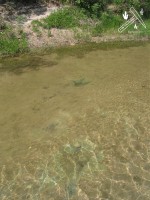
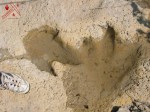
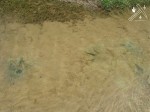
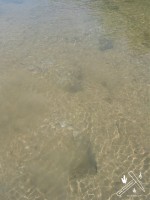
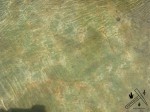

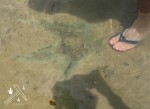
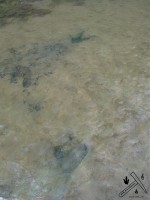
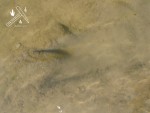
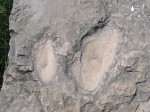

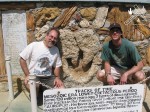
 at the campground site01.jpg)



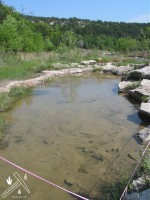

SECOND ROW: 7) Acrocanthosaur track-campground site on of 8 in a row. 8) Acrocanthosaur tracks in a row at campground site. 9) An uncleaned track at the campground site. 10) Erosional markings (of the Glen Rose Limestone) that were once mistaken for human prints. 11) Glen at campground site 12) John and Glen at Track in Glen Rose Square.
THIRD ROW: 13) John pointing out a nice Acrocanthosaur track (Eubrontes glenrosensis) at the campground site. 14) Nice Acrocanthosaur track from campground site. 15) Ornithopod track from Taylor Site. 16) Paluxy track from Sommvervell Museum. 17) Part of the Main track site and the extension of the Roland Bird Excavation in the AMNH. 18) Sauropod Tracks at the main track site.
Dinosaur Track Found in Alaskan Park
ANCHORAGE, Alaska - A track from a three-toed dinosaur believed to be about 70 million years old has been discovered in Denali National Park, the first evidence that the animals roamed there, scientists said. The footprint was found June 27 by a University of Alaska Fairbanks student taking a geology field course. The fossil is 9 inches long and 6 inches wide, officials said. The discovery's importance was its location in Interior Alaska, far from the coastline where other tracks have been found, said Anthony Fiorillo, curator of earth sciences at the Dallas Museum of Natural History. "It's not necessarily the track itself that's significant," he said. "It's where it is that's got us all excited." From the size of the track, he estimates the meat-eater was 9 to 13 feet long. "You are looking at a very large, birdlike animal except it has teeth and a tail and instead of wings, it has arms," he said. A rough comparison, he said, would be a scaled-down Tyrannosaurus rex. Susi Tomsich, an undergraduate at the University of Alaska Fairbanks, spotted the track on the underside of a ledge. "Something told me to look around and I did and I spotted this one," she said. She pointed it out to Paul McCarthy, associate professor of geology, who instantly recognized what she had found. "I gave a little howl," McCarthy said. "It was a big rush." By DAN JOLING, Associated Press Writer Wed Jul 6, 8:46 AM ET
http://news.yahoo.com/s/ap/20050706/ap_on_sc/denali_park_dinosaur_5;_ylt=AjSn_dq0ihlNXyuRTWFNAMdsaMYA;_ylu=X3oDMTA5bGVna3NhBHNlYwNzc3JlbA--
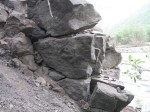
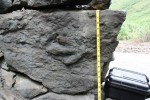
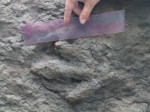
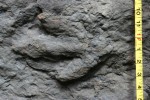

Dinosaur Tracks Found in Utah Coal Mines
CHESTERFIELD COUNTY, Utah - This gigantic footprint, the largest yet found in Utah, measures 4 feet 5.5 inches long; 2 feet 8 inches wide; the stride was 12 feet and width of trackway 3 feet 8 inches. It was donated by Mr R W Magraw, of the Chesterfield Coal company, to the University of Pennsylvania, his alma mater. Mr E H Burdick, Utah state geologist, had a replica made which is in the Strevell collection. The existing conditions and the number of tracks exposed in the mine workings at Standardville make it possible to measure accurately a dinosaur's stride and trackway. We found four tracks 34 inches long, 27 inches wide, evidently made by the hind feet of a large three-toed dinosaur. The stride was 10 feet 4 inches, trackway 3 feet 7 inches. Nearby we found a four-toed track 16 inches long. An interesting feature is that many, if not the majority of the tracks, show that the dinosaurs were walking in an easterly direction. It is said that "in England the tracks all run one way, from west to east." The discovery and collection of these footprint casts has been of great interest to eastern paleontologists, owing to their size, compared with those of the Connecticut Valley as well as to local scientists and enthusiasts.
http://www.stadiumweb.com/reprints/dinosauropodes.html
